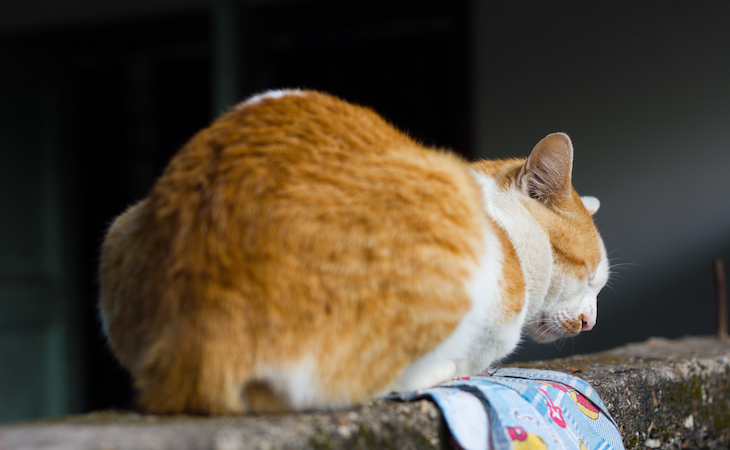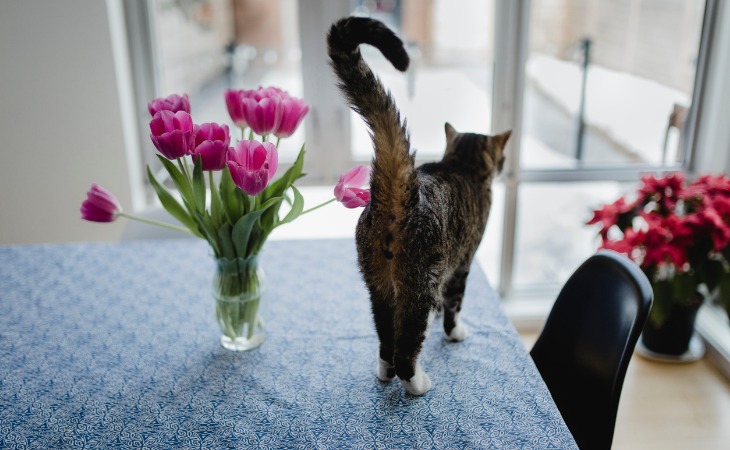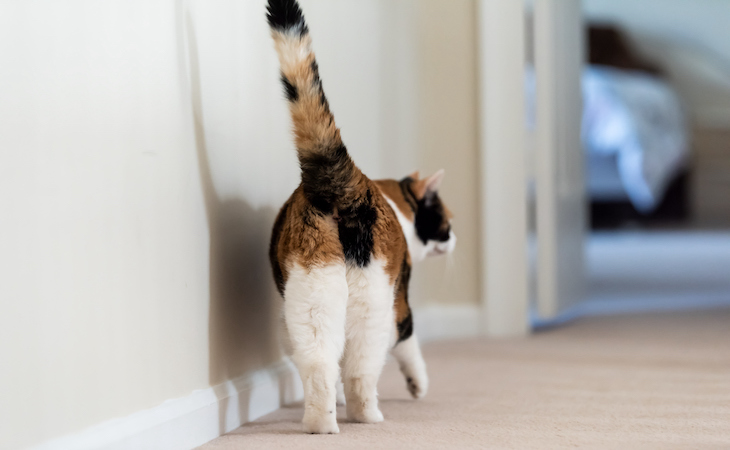One of the characteristic behaviors of cats is the sometimes “fancy” gestures they make with their butts. You probably remember the last time your cat turned around to show you its bottom. But what does this mean? Here are 6 things you should know about your cat’s bottom!
Cats use their butt to communicate
Cats have anal glands located on both sides of their anus. These anal glands produce a fluid that has a unique odor, specific to each cat. Depending on the cat, the fluid can be liquid or pasty. The color of the fluid varies from yellow to dark brown.
For humans, the smell of this anal fluid is rather unpleasant. For felines, however, it is a very important form of communication. It is a sort of identity card that contains precise information about the cat that produced it:
- Its emotions,
- Where it comes from;
- Its social rank.
For example, when your pet is stressed (or intensely afraid), its anal glands produce alarm pheromones that are designed to ward off whatever is frightening it. This often happens at the vet’s office. Additionally, when there are several cats in a house, it is partly thanks to their anal secretions that they can recognize each other. That’s why they often have the habit of sniffing each other’s butts.
A cat’s butt give clues about its health
One of the functions of a cat’s bottom is to ensure the evacuation of waste from the animal’s digestive system through the anus. By paying attention to this part of your cat’s body, you can learn a lot about its health. For example, when your cat starts dragging its butt on the floor incessantly, it’s a clear sign that something is wrong. It may be itching due to a blockage in its anal glands.
Sometimes, worms can also be the cause of the itching that makes your cat drag its butt on the floor. Lastly, the problem can also be due to an environmental allergy (pollens, mites, fleas, molds) or a food allergy (dairy products, chicken).
The shape of your cat’s poop also tells you a lot about his health. If it’s well-formed, it’s a good sign. If it’s watery, there may be a problem.

A cat uses its butt to stay balanced
Have you ever noticed that before pouncing on an object or attacking prey, your cat wiggles its butt in a strange way? It’s a natural movement that allows it to find the optimal balance to pounce effectively. In other words, wiggling its bottom is a way for it to gain stability before attacking.
Cat use their butts to show affection
Cats are much more expressive than most people think. Their bum is one of the organs they use to send messages or signals to others. When your furry friend shows you its bottom, it’s not meant to annoy or provoke you. It is not a sexual gesture either.
It’s simply a sign of affection. By showing you its bottom, your cat is indicating that it considers you an important person in its life. Sometimes, it may even rub its butt against your face. This is an instinctive behavior that all felines acquire sometime after birth.
Moreover, when your cat shows you its butt, it means that it trusts you a lot. It is indirectly allowing you to learn about its personal information. Of course, it doesn’t expect you to sniff its anus, but the gesture is still symbolic.
Cat butts are very sensitive
The butts of felines are very sensitive parts of their bodies. This is due to the presence of a large number of nerves in their perianal area. Therefore, when a cat injures its butt, it feels very intense pain.
This area in particular is also very susceptible to certain infections. For example, if your cat is overweight and can’t groom itself properly, inflammation can appear in the bum area (the anal area). It is therefore important to pay close attention to this part of your feline’s body so as not to let it suffer. Note that anal glands can also cause inflammation in your feline’s anus if it is obese.

Cats sometimes clean their butts by rubbing them on the floor
Because of its anatomy, your cat cannot touch its anus with its paws. However, it is not uncommon for excrement or small insects to get stuck in the hair in this area. To relieve itself in these situations, the animal rubs its buttocks on the ground. The pressure it exerts on the ground with its buttock muscles is usually enough to clean up the hair around its anus.
How to clean a cat’s butt properly
Now that you know all about your cat’s bottom, how do you clean it to ensure your furry friend’s optimal well-being? Here are some practical tips.
Regularly clean the remains of feces that are stuck to its hair
Sometimes your cat’s health (or age) prevents it from cleaning itself properly. In these cases, you should help her. Using cat wipes or washcloths, periodically wipe off any remaining feces that are stuck to its back hair. Be gentle and tactful so as not to irritate your cat’s skin.
Be careful not to use any chemicals during these grooming sessions. Intimate wipes and baby wipes should be avoided.
Trim hair around the butt as needed
If there is too much hair in the area around your cat’s anus and you are unable to clean it properly, you can trim it. To do this, you’ll need a special trimmer, available at pet stores. If in doubt, call a professional groomer.
Give your cat a suitable bath
If the poop that’s stuck to your pet’s fur is too hard or too thick, then you can give it a bath. Soak its butt in plain water (mixed with cat shampoo) to soften the knots. You can then put on rubber gloves to finish the grooming. Of course, this can be a tricky ordeal, as most cats aren’t big on bathing. You’ll need to trim its claws beforehand to prevent it from hurting you if it doesn’t let go. You can also tire your cat out beforehand by playing with it and make sure you’ve closed the bathroom door.
Your cat’s butt is one of the most multipurpose organs in its body. It’s used for communication, relief, and balancing before attacking prey. It’s also a very sensitive area. Therefore, don’t hesitate to visit your local veterinarian if you have a problem.

